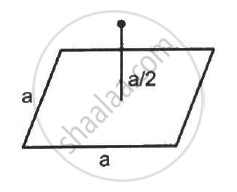Advertisements
Advertisements
प्रश्न
Two small spheres 18 cm apart have equal negative charges and repel each other with the force of 6 × 10-3 N. Find the total charge on both spheres.
उत्तर
Given: F = 6 × 10-3 N, r = 18 cm = 18 × 10-2 m
To find: Total charge (q1 + q2)
Formula: F = `1/(4πε_0)("q"_1"q"_2)/"r"^2`
f = `(9 xx 10^9 xx "q"^2)/(18 xx 10^(-2))^2`
`(f xx (18 xx 10^(-2))^2)/(9 xx 10 ^9) = "q"^2`
q2 = `(6 xx 10^(-8) xx 18 xx 18 xx 10^(-4))/(10^9)`
q2 = `(6 xx 36 xx 10^(-12))/(10^9)`
∴ q2 = 216 × 10-21
q2 = 21.6 × 10-20
q = `sqrt(21.6 xx 10^-20))`
∴ q = 4.648 × 10-10 C
∴ q = -4.648 × 10-10 C
∴ Total charge = 2q
= 2 × (-4.648 × 10-10)
= 9.296 × 10-10 C
APPEARS IN
संबंधित प्रश्न
A polythene piece rubbed with wool is found to have a negative charge of 3 × 10−7 C.
(a) Estimate the number of electrons transferred (from which to which?)
(b) Is there a transfer of mass from wool to polythene?
How does Ampere-Maxwell law explain the flow of current through a capacitor when it is being charged by a battery?
Write the expression for the displacement current in terms of the rate of change of electric flux.
Mark out the correct options.
A charge Q is placed at a distance a/2 above the centre of a horizontal, square surface of edge a as shown in the following figure . Find the flux of the electric field through the square surface.

Two large conducting plates are placed parallel to each other with a separation of 2⋅00 cm between them. An electron starting from rest near one of the plates reaches the other plate in 2⋅00 microseconds. Find the surface charge density on the inner surfaces.
Two large conducting plates are placed parallel to each other and they carry equal and opposite charges with surface density σ as shown in the figure. Find the electric field (a) at the left of the plates (b) in between the plates and (c) at the right of the plates.

Two particles A and B with charges q and 2q, respectively, are placed on a smooth table with a separation d. A third particle C is to be clamped on the table in such a way that the particles A and B remain at rest on the table under electrical forces. What should be the charge on C and where should it be clamped?
A smple pendulum consists of a small sphere of mass m suspended by a thread of length l. The sphere carries a positive charge q. The pendulum is placed in a uniform electric field of strength E directed vertically downwards. Find the period of oscillation of the pendulum due to the electrostatic force acting on the sphere, neglecting the effect of the gravitational force.
Choose the correct option.
An electron is placed between two parallel plates connected to a battery. If the battery is switched on, the electron will
Two small conducting spheres of equal radius have charges +10 µC and -20 µC respectively and placed at a distance R from each other experience force F1· If they are brought in contact and separated to the same distance, they experience force F2. The ratio of F1 to F2 is ____________.
A conducting sphere of radius 0.104 m has an unknown charge. If the electric field at 0.20 m from the centre of the sphere is 1.5 x 103 NC-1 and points radially inward, what is the electric flux?
Electric charge is a property of ______.
Assertion: The positive charge particle is placed in front of a spherical uncharged conductor. The number of lines of forces terminating on the sphere will be more than those emerging from it.
Reason: The surface charge density at a point on the sphere nearest to the point charge will be negative and maximum in magnitude compared to other points on the sphere.
A solid sphere of radius R1 and volume charge density `rho = rho_0/"r"` is enclosed by a hollow sphere of radius R2 with negative surface charge density σ, such that the total charge in the system is zero. `rho_0` is a positive constant and r is the distance from the center of the sphere. The ratio R2/R1 is ______.
When a glass rod is rubbed with silk, it ______.
Two charges q1 and q2 are placed in vacuum at a distance d and the force acting between them is F. If a medium of dielectric constant 4 is introduced around them, the force now will be ______.
Equal charge are given to two-sphere of different radii. The potential will be
Which one of the following is the unit of electric charge?
A certain charge Q is divided into two parts q and (Q - q). How should the charges Q and q be divided so that q and (Q - q) placed at a certain distance apart experience maximum electrostatic repulsion?
A straight infinitely long cylinder of radius R0 = 10 cm is uniformly charged with a surface charge density σ = + 10-12 C/m2. The cylinder serves as a source of electrons, with the velocity of the emitted electrons perpendicular to its surface. Electron velocity must be ______ × 105 m/s to ensure that electrons can move away, from the axis of the cylinder to a distance greater than r = 103 m.
A particle of mass m and charge q is placed at rest in a uniform electric field E and then released. The kinetic energy gained by the particle after moving a distance of y will be ______.
Two particles A and B having the same mass have charges +q and +4q, respectively. When they are allowed to fall from rest through the same electric potential difference the ratio of their speeds vA to vB will become ______.
